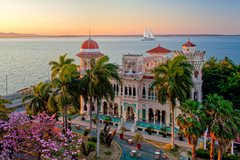
As Cuba emerges from its sixty-year political and economic isolation, travelers from across the globe are discovering the rich treasure trove of culture that is this tiny island nation. For explorers who delight in the unspoiled and authentic, Cuba's isolation has done much to preserve her architectural gems. Lovers of the principles of Spanish enlightenment take particular delight in Cuba's unquestioned architectural jewel: Cienfuegos.
Founded in 1819 by Spanish settlers, Cienfuegos was originally named “Fernanda de Jagua,” in honor of Spain's King Ferdinand VII, but the most significant influence was French, thanks to the significant population of that country’s settlers in the heart of the mango, coffee, tobacco, and all-important sugar cane plantations. These French colonists, who hailed from both France itself and its cultural satellites such as Louisiana, brought with them their signature style elements of stained glass and ironwork, much of which survives today.
The city, which was re-christened “Cienfuegos,” meaning “100 fires,” is one of the finest examples of European 19th century urban planning in Latin America, reflected primarily in the central design scheme of 25-square blocks. The city was developed in the early and mid-nineteenth century with particular attention to modern concerns such as hygiene and an emphasis on the role of public squares, places, and buildings. When the railroad arrived in 1860, building efforts continued with even more enthusiasm, leading to some of the finest sacred and secular buildings of the nineteenth century, such as the Bishopric, the San Lorenzo school, the government palace, and the Customs House which are still delightfully intact, as are many of the charming pastel-colored houses and shopfronts.
Modern-day Cienfuegos is bolstered by the key industries of shrimp fishing, thermoelectricity, petrochemicals, and shipbuilding, as well as the significant designation in 2005 by UNESCO of Cienfuegos as a World Heritage Site. But perhaps the coastal city’s most enduring endorsement is that of Cienfuegos's favorite son, the Cuban singer Benny Moré, whose hit song “
La ciudad que mas me gusto a me,” immortalized the charms of “the city [he] loves best.”
Discover Cienfuegos's charms on one of Alexander + Roberts's distinctive itineraries to Cuba, such as
Cuba by Sea: an intimate voyage combining luxury and exploration in one unforgettable journey.